Herbs and plants are a ubiquitous image in skincare. It is clear that skincare brands want their products to be associated with natural ingredients, promoting the idea of herb to bottle with little in the way of processing. However, these commercial products are rarely 100 percent natural, a quick glance at the label will show you that there are many more ingredients beyond the raw herb.
In this series we will spotlight 10 herbs and look at their rich healing properties. With more knowledge about herbs we can all take a more active role in protecting our skin. Rather than browsing a store for a particular herb extract, why not grow it at home and produce a DIY skincare formula from the fresh leaves.
Aloe Vera

Origin and use
Aloe Vera is native to the sandy soil and semi-tropical climate of the mediterranean and North Africa. The Egyptians used the plant for multiple medicinal purposes, naming it the ‘plant of immortality’.
Aloe vera gel might not give you everlasting life, however, it will protect your skin from damaging environmental stressors.
Properties and health benefits
Aloe vera gel has a myriad of benefits. The gel is a natural anti-inflammatory, antibacterial and antiseptic, meaning it can aid the healing process of skin.
If you have suffered from a burn or have a painful rash or wound, aloe vera will provide soothing comfort, while cleansing the irritated area of harmful bacteria.
Caring for your herbs
Given aloe vera is native to some of the warmest parts of our planet, you can probably guess what it needs. Find the part of your home which receives the most sunlight and make sure the soil is sandy with excellent drainage.
Aloe vera is resilient, however, as a succulent there is a danger you can over water it. To avoid this, place your finger into the topsoil to make sure it is completely dry before watering.
Helpful Tips
To harvest your aloe vera gel take a sharp knife and slice the edges of the leaf. Once you have cut the leaf open, take the knife and gently scrape out the gel. Wash off any impurities and then it is ready to use.
The beauty of aloe vera gel is that it is a ready made formula. Simply apply it to the patch of damaged skin and leave it to absorb overnight.
Nettles
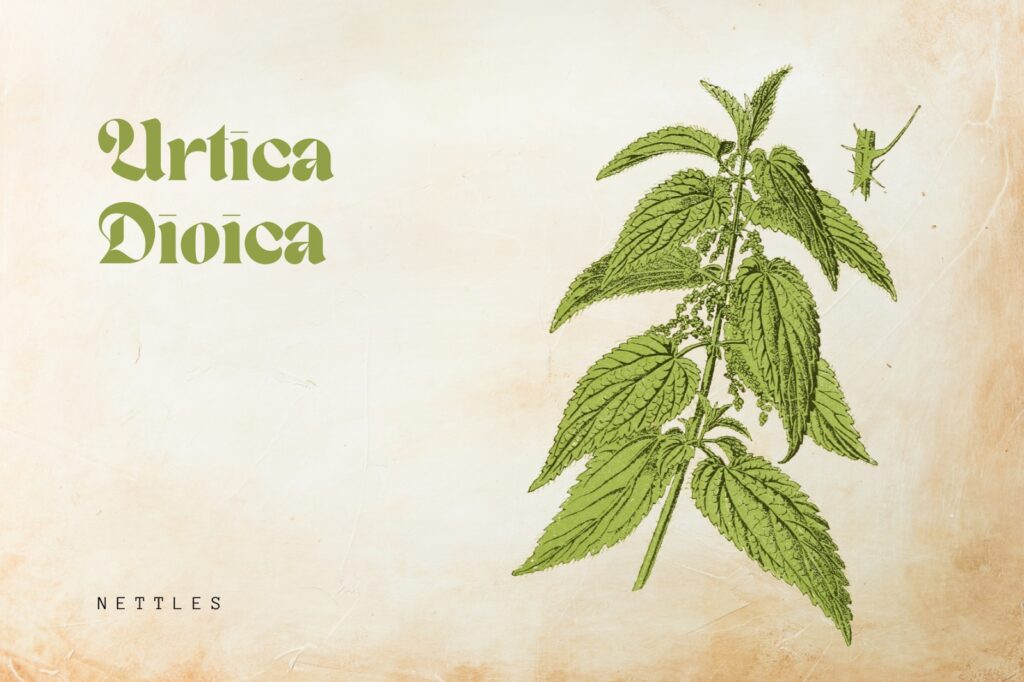
Origin and use
Stinging nettles might have a reputation as a plant to avoid, however it has a long history of medical use. Unlike aloe vera, it thrives in colder climates, growing liberally in the countries of Northern Europe.
Properties and health benefits
The stand out benefit of nettles is that they are an anti-inflammatory. For those with skin conditions such as eczema they can be applied topically to reduce flare ups.
Nettles aren’t only good for your skin. The dry leaves can be used as a base for a healthy tea. The flavour is surprisingly pleasant, slightly sweet with earthy undertones. Nettle tea壯陽藥 acts as a natural diuretic and is full of vitamin A and B.
If you are feeling a little brave, the sting of the herb is a proven pain relief. A study published by the University of Plymouth (Larkin. M, 2000), revealed that nettles eased the joint pain of arthritis patients; the patients’ overall levels of pain remained suppressed throughout the trial. The researchers commented that this was likely due to the presence of serotonin and histamine in the nettles.
Caring for your herbs
Growing nettles is quite a straightforward task, however without care they could spread to unwanted areas of your garden. So, it is best to harvest the nettle regularly during the peak growth months, June to September.
The nettle is happy to sit in the sun or in a shaded area, just remember to keep the soil moist.
When harvesting nettles make sure you wear gloves and clothing which covers your arms. The sting, the defence system of the herb, will release formic acid which can cause hives and rashes.
Helpful Tips
To start handling nettles for your skincare recipe you will need to disarm its defence system. Place the leaves you have harvested into boiling water, this will neutralise the sting.
Thyme
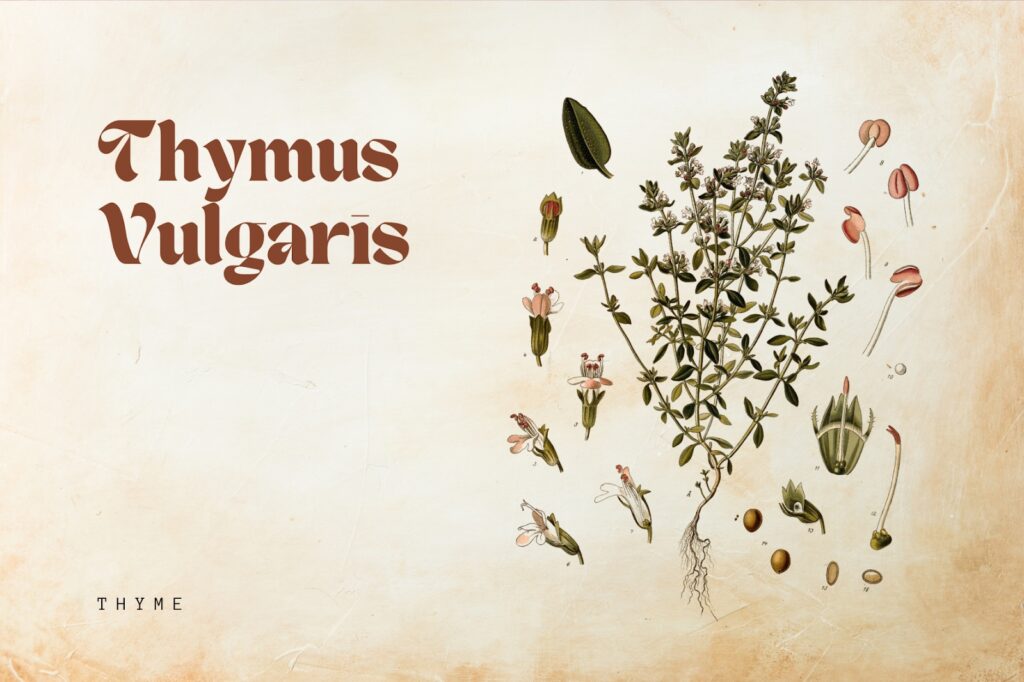
Origin and use
Thyme is another herb that played an important role in ancient cultures. The Greeks used thyme to fumigate their home and the Romans used it extensively in their diet, it enhanced the taste and flavour of many of their dishes.
Properties and health benefits
Thyme oil contains properties that are effective at combating acne causing bacteria such as COX-2 enzyme. The oil can also repair scarred skin by helping dead skin cells shed.
Thyme has long been used for its health benefits, particularly in connection with respiratory issues like congestion. The herb has a reputation as an antispasmodic, helping to calm coughs and convulsions by warming the throat and lungs.
Caring for your herbs
Thyme will grow best in the springtime, after the cold winds and frosts have gone. Make sure you give the herb plenty of sunlight and well draining soil. The more sunlight it receives the more oil it will produce. Thyme doesn’t need too much maintenance, however you should regularly cut back some of its foliage, for more efficient growth. Don’t take more than a third of the leaves and dead shoots.
Helpful Tips
When using your thyme oil make sure you dilute it with a carrier oil. Essential oils are powerful substances and need to be used sparingly. Mix thyme oil with a carrier, like coconut oil or aloe vera gel, and it will be safely absorbed into the skin.
Ashwagandha

Origin and use
Ashwagandha, sometimes referred to as Indian ginseng, is a herb that was widely used in traditional Ayurvedic medicine. Its berries and roots are used in a variety of treatments for ailments relating to pain and stress.
The herb, native to Asia and Africa, is now a popular supplement throughout the world.
Properties and health benefits
Ashwagandha, aside from its ability to reduce the impact of stress events on the body, has many benefits for your skin: it assists with healing scarred skin, helps fight free radicals that create dark spots and wrinkles.
Ashwagandha is also able to strengthen your hair and scalp. The herbs contain compounds that can trigger melanin production, this will help your hair retain its color.
Caring for your herbs
Ashwagandha grows in India at the start of the rainy season before the monsoon season. In this period of time the climate is hot and humid. Even although you might not be able to replicate these exact conditions in your living room, you should be able to grow the herb to maturity. Make sure not to overwater the soil and move the herb into the sunniest part of the room.
Helpful Tips
You can buy the Ashwagandha powder and use it in a number of DIY recipes:
The herb can be applied topically to reduce uneven pigmentation – simply mix the powder with a little water and dab it on the affected patches of skin.
If you want to soothe inflamed and overly red skin, mix the powder with dried ginger and lemon peel, and boil the mixture in water. Once cool, strain the mixture and apply it to your face.
Mint

Origin and use
If you look at your skin care products you will likely have noticed the ingredient menthe. Menthe is the scientific name for mint. Mint has always been used as a cosmetic product due to its aromatic potency.
Properties and health benefits
The fresh scent is not the only important property of mint. Mint is full of vitamin A and salicylic acid which inhibits the production of sebum oil. Sebum oil coats the skin with a protective wax however, if your body overproduces it, you will likely get more spots and pimples.
Another type of mint, peppermint, contains menthol which can help with stomach issues by soothing the digestive tract.
Caring for your herbs
Alongwith most of the herbs we have highlighted, mint needs little attention to grow. However, you should look out for rust – small orange spots which are signs of a fungal infection.
Make sure your mint is in a separate pot or kept apart from other herbs in the garden as it will compete for sunlight. Poke holes in the pot to provide drainage for the soil. And keep cutting the stems and leaves back to stimulate new growth
Harvest when they are young and their leaves are fresh and brimming with oil. It is best harvested from spring to summer.
Helpful Tips
You can use mint to make toners, face masks for your skin or add it to teas and smoothies for benefits to your gut. Try mixing mint with oatmeal and honey to make a cleansing face mask. Simply tear the leaves from the stem and grind it into a paste. Then fold this paste into a bowl with your extra ingredients.
Calendula
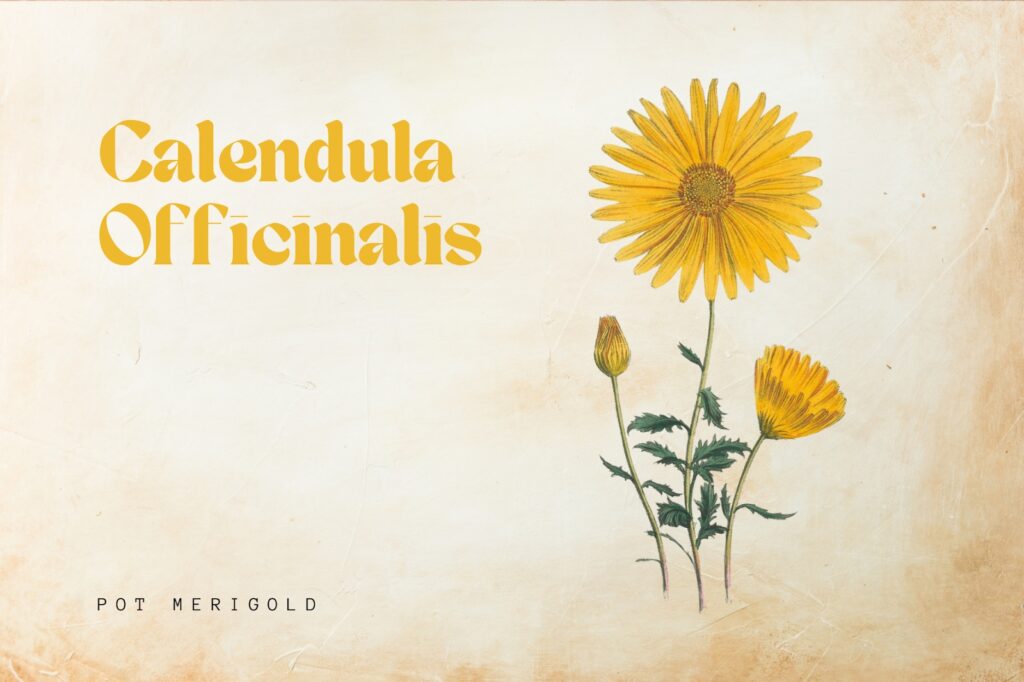
Origin and use
Calendula is a perennial herb which blooms from spring to autumn. Throughout history its beauty has captivated many cultures. The Greeks and Romans both used Calendula as a decoration during their public ceremonies. To many it was a symbol of permanence and natural beauty.
However, calendula is not just aesthetically pleasing. It had an altogether more serious role to play in various world conflicts. On the American Civil war battlefields, medics and nurses carried around the herb’s petals. The petals were rubbed into soldiers’ wounds to accelerate hemostasis.
Properties and health benefits
Calendula benefits are innumerate.
It is packed with powerful antioxidants – carotenoids and flavonoids – which can turn damaged and lined skin into supple skin. If your skin is prone to becoming very dry then calendula is the herb for you. Calendula oil relieves dryness and stimulates collagen production which is key to healthy and youthful skin. Calendula is a light oil that the skin can absorb easily, meaning your skin will look better in a matter of hours.
Caring for your herbs
Calendula favours cool and shady conditions, so try to find a spot in your garden that is sheltered from the wind and rain. If your garden is too exposed, bring the herb inside and plant it in a pot.
Helpful Tips
Calendula oil needs to be mixed with a carrier oil. So, why not mix it in a solution of warm water and coconut oil. Enjoy the pleasant sensation on our skin, combined with the soothing and relaxing smells
Basil
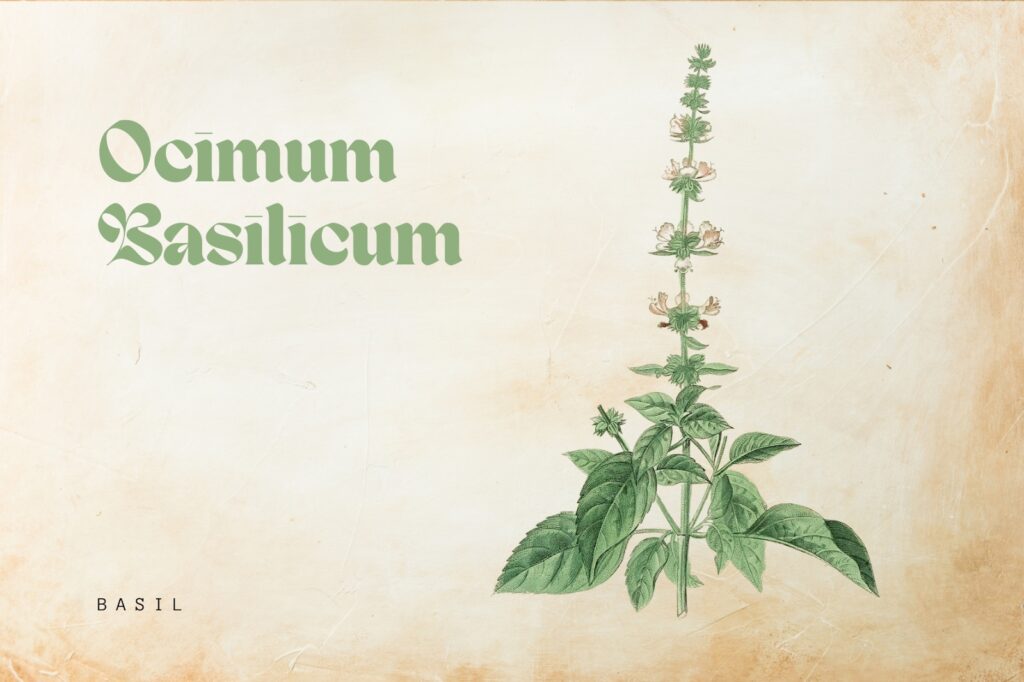
Origin and use
We normally associate basil with its culinary uses. However, the leaves brim with oil that is fantastic for skin health.
A research paper from 2012 (Barbalho, S.M. et al., 2012) suggests we should view basil as much more than a tasty condiment. In a summation of the herb’s properties, the researchers concluded that basil has anti-inflammatory and antioxidant effects. It also noted multiple studies which revealed that basil is effective as an antimicrobial agent.
Properties and health benefits
The presence of antioxidants in basil oil will help destroy harmful free radicals.
Free radicals are unstable molecules that are missing an electron. If they cannot bind with an electron, they will attack other molecules. This attack will trigger oxidative stress in the skin cells.
If free radicals are not neutralised they will continue to disrupt the action of skin cells. This disruption over time can make the skin look less vibrant. For example, there will be signs of ageing such as lines and wrinkles.
Caring for your herbs
Grow your basil seeds in the spring to summer months. Keep the soil moist initially, but after the herb is established use water sparingly. When watering make sure to only water the soil, if the leaves get wet they will likely produce mold.
Harvest leaves individually rather than taking the whole stem.
Helpful Tips
In order to extract the healthy oil you need a mortar and pestle and a strainer. Grind the leaves into a juicy pulp and then leave the remnants in a sunny spot for a day. Then, place the pulp into a strainer and press on the broken leaves to remove all of the oil.
Rosemary
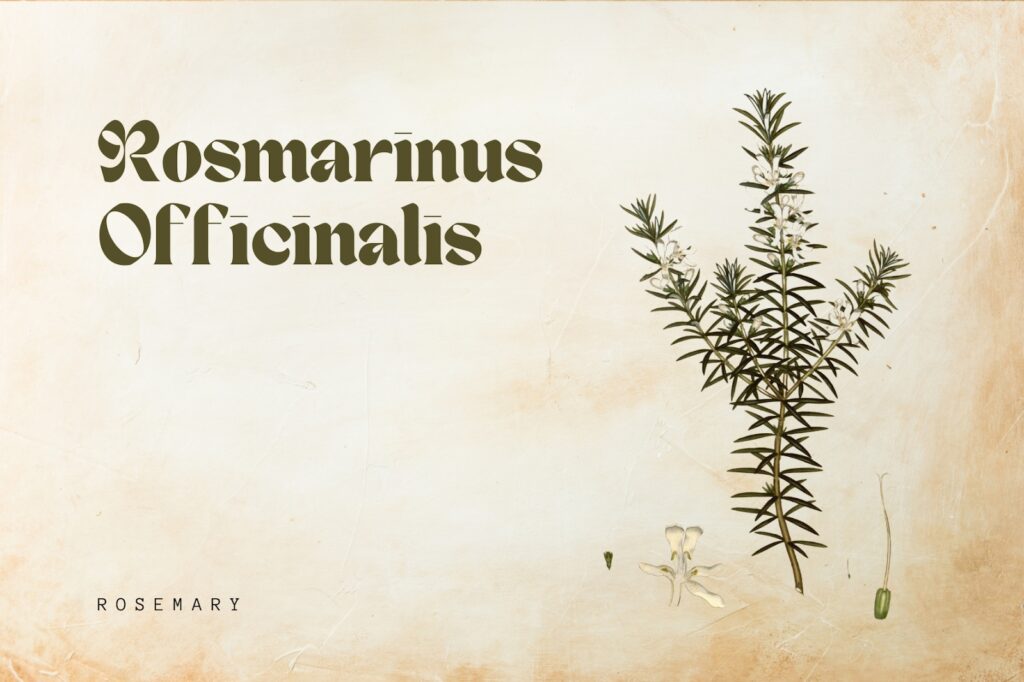
Origin and use
We all know rosemary as a garnish on top of many of our favourite dishes. Its pungent scent can transform more bland food items. However, away from the kitchen, you should learn the uses of rosemary oil as a medicinal and cosmetic product.
Properties and health benefits
Rosemary is rich in minerals that are good for your skin such as iron and vitamins. Like basil, it can fight off free radical activity and heal skin after sun exposure.
Rosemary oil is often used by skincare brands as a cleanser. So, you can use rosemary oil to remove the impurities from your pores. After you cleanse your skin, it will feel lifted and taut, this is due rosemary oil being a natural astringent.
Caring for your herbs
Rosemary is pretty robust and evergreen all year round. So, you should consider rosemary as an addition to your new DIY herb garden.
When planting your herb, make sure it sits in well-drained soil. If you only have heavy clay soil, add some grit or small stones to improve drainage.
In the warmer months make sure it receives plenty of water. In the colder months consider bringing the plant indoors to protect it from the rain.
Helpful Tips
Aside from the benefits to your complexion, rosemary oil could help you combat mental fatigue. The ancient Greeks used to wave smouldering rosemary above students’ heads during exams, hoping the scent would improve their mental sharpness.
Tales like these from the ancient world always seem more myth than fact. However, one recent scientific study suggests that rosemary does affect our mental sharpness. The study (McCaffery.R. et al., 2009) found that the aroma of rosemary essential oil improved the performance of nursing students in one of their exams. The scientists explained that this was due to a decrease in cortisol levels.
So, why not incorporate rosemary into your skincare routine and increase your mental alertness.
Chamomile
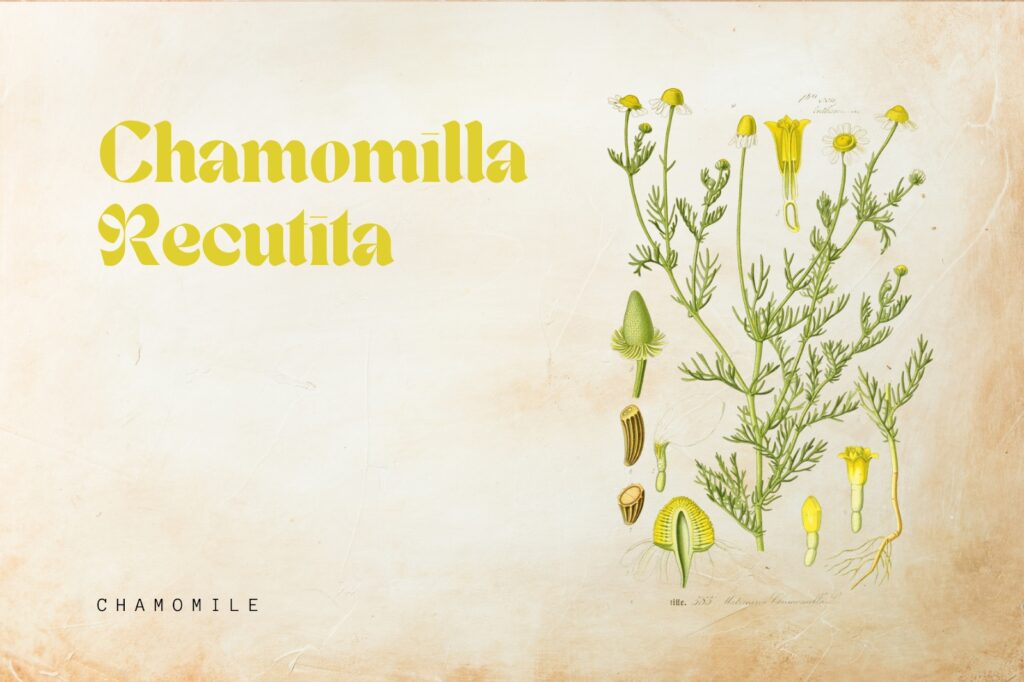
Origin and use
If you are currently sipping on some chamomile tea you might be wondering, what are chamomile benefits for skin?
There are two types of chamomile herb – Roman and German. The German type is more useful in skincare as it contains greater quantities of bisabolol.
Properties and health benefits
So, what is bisabolol? And why is it good for your skin?
Well, bisabolol is a natural chemical in German chamomile that is often used in skincare products like creams and lotions.
The compound has been found to benefit the skin in a number of ways : it protects the skin against UV damage, it soothes angry rashes and can help fight bad bacteria.
This means that products containing chamomile extract are perfect for days at the beach. Also you should consider looking for bisabolol if you have problems with acne.
Caring for your herbs
This herb loves the light. Give it a spot in direct view of the sun and only return occasionally to water it.
The only potential issue with chamomile is that it is vulnerable to pests. Aphids and mealybugs will attack it when it is weakened by lack of water. So, you might want to put a companion plant beside it that will draw away insects and pests.
Helpful Tips
How about using chamomile tea to promote healing on the inside and outside of your body.
Treat yourself with a DIY chamomile tea facial to reduce puffiness and fatigued looking skin. Firstly boil the chamomile tea to drink and then place the used tea bags underneath your eyes. It will help combat the dark circles and bags which form due to tiredness.
Lavender
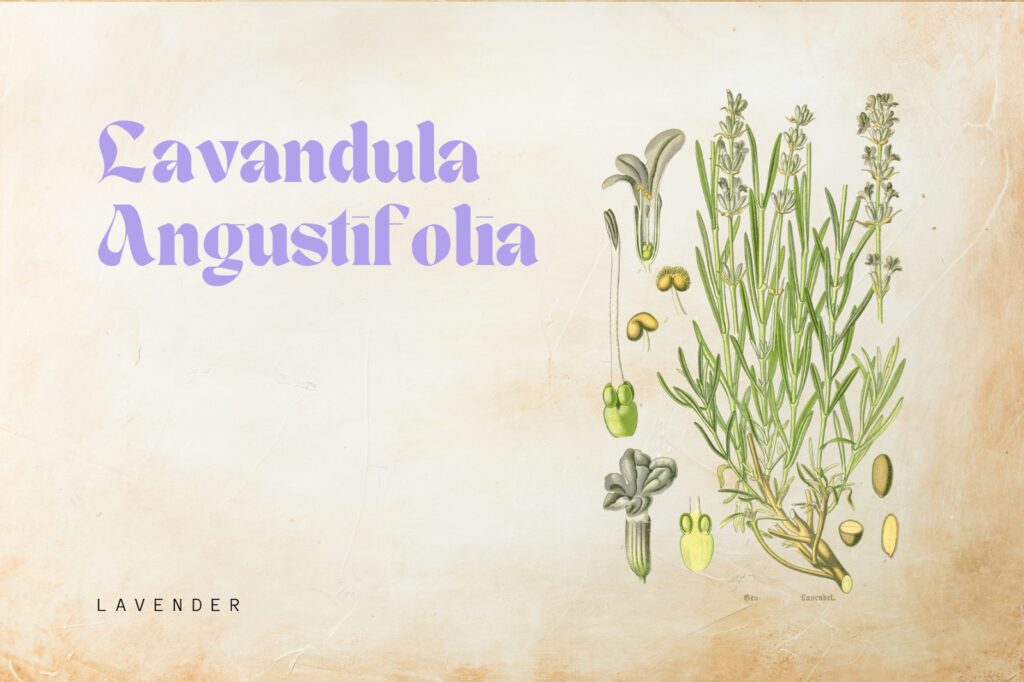
Origin and use
The great aromatic smell of lavender takes a moment of relaxation to a higher level. People have always been drawn to the herb and wanted to apply it to their body. For example, the Romans used lavender when bathing, scattering the petals in the warm water.
Properties and health benefits
Lavender is a powerful anti-inflammatory and antiseptic. So, if you have eczema, acne or psoriasis it can counteract the redness and other symptoms you experience. Another reason to opt for lavender oil is that it provides pain relief from inflammation. Swollen or uneven skin is not something that we want to heal just for aesthetic reasons, it can also be very painful. Lavender oil can numb the surface of the skin, while the chemical beta-caryophyllene in the oil works to reduce the inflamed area.
Caring for your herbs
There are many types of lavender, and some are more resilient than others. Generally, lavender can be a little sensitive to humid conditions and moisture. So, make sure the soil doesn’t get waterlogged and the herb is in an airy place.
Harvest in late summer and cut away dead shoots without flowers.
Helpful Tips
Lavender oil is an essential oil which needs to be infused with a carrier. Once you have diluted the oil you can include it in many recipes. Or if you have limited time, simply use the dry leaves and crumble them into a warm water solution.
If you can’t get enough of the scent of lavender. Try placing the dry leaves into a small linen pocket and put in your bed or inside your linen drawer. Your blankets will take on the sweet and fresh smell.
Discover more about these remarkable herbs and how to grow them.
- https://www.gardenersworld.com/
- https://www.thelancet.com/journals/lancet/article/PIIS0140-6736(05)72915-9/fulltext
- https://pubmed.ncbi.nlm.nih.gov/19258850/
- 壯陽藥 k” rel=”noreferrer noopener”>http://news.bbc.co.uk/1/hi/health/771563.stm






